What Is Dopamine Addiction? Understand & Overcome It Today
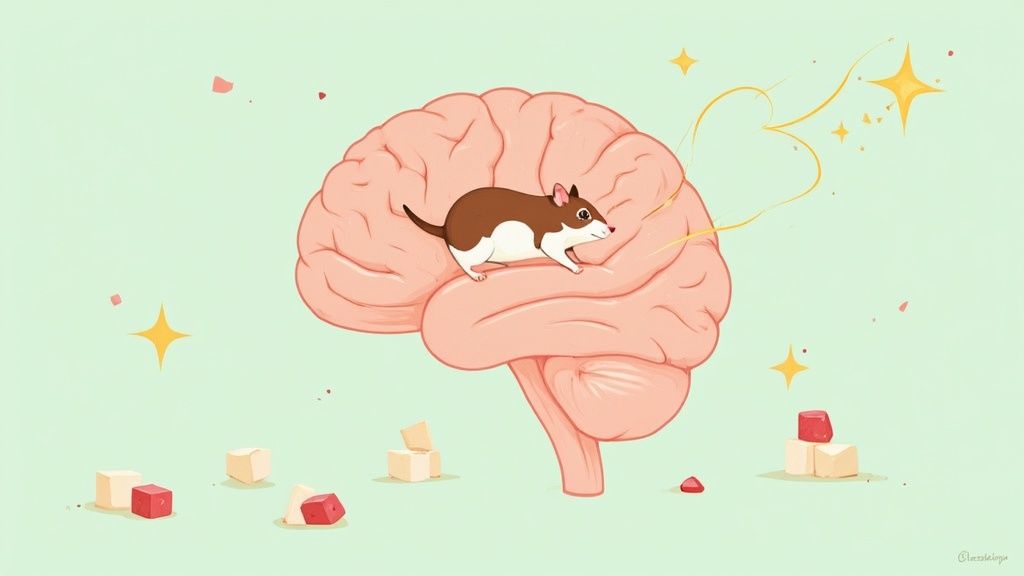
While "dopamine addiction" isn't an official medical diagnosis, it's a very real way to describe the compulsive chase for a reward that your brain can get locked into. We often hear dopamine called the "pleasure molecule," but it's more accurate to think of it as the motivation molecule. It's the neurochemical that pushes you to seek out things you find rewarding, from sugary snacks to social media likes.
When this system goes into overdrive, it can make the simple, quiet moments of everyday life feel dull and uninteresting compared to the promise of the next big dopamine hit.
The Hidden Driver Behind Your Cravings
Ever found yourself mindlessly scrolling through your phone or reaching for another cookie when you're not even hungry? You can thank your brain's reward system for that. Dopamine is the star player here, sending a powerful message to your brain: "Hey, that felt good. Let's do it again!"
Think of it like a hamster on a wheel. The first spin is a new, exciting experience. But after a while, that same spin doesn't feel as thrilling. To get that initial rush back, the hamster has to run faster and longer. This is exactly what happens in your brain when it gets caught in a dopamine loop—you need more and more of the stimulus just to feel normal.
How Modern Life Hijacks Our Brains
Our world is absolutely saturated with what scientists call "supernormal stimuli." These are things engineered to trigger an unnaturally large release of dopamine. A vibrant notification on your phone, a hyper-palatable processed snack, or an endless video feed—they're all designed to hook you and keep you coming back for more.
This constant flood of high-reward stimuli starts to desensitize your brain's reward pathways. Over time, activities that once brought you genuine joy, like reading a book or going for a walk, just don't cut it anymore. They feel boring. Your brain starts to crave only those high-intensity rewards, creating a vicious cycle of seeking, consuming, and ultimately, feeling unsatisfied. This is the heart of what we call dopamine addiction.
Dopamine addiction is often discussed in the same breath as substance use disorders (SUDs) and behavioral compulsions, since dopamine is central to the brain's reward system. Powerful stimulants can actually cause structural changes in the brain that intensify cravings and make it incredibly difficult to resist a relapse. You can explore more about dopamine's role in the brain for a deeper understanding.
The image below gives you a clear picture of how different activities can cause dopamine to spike.
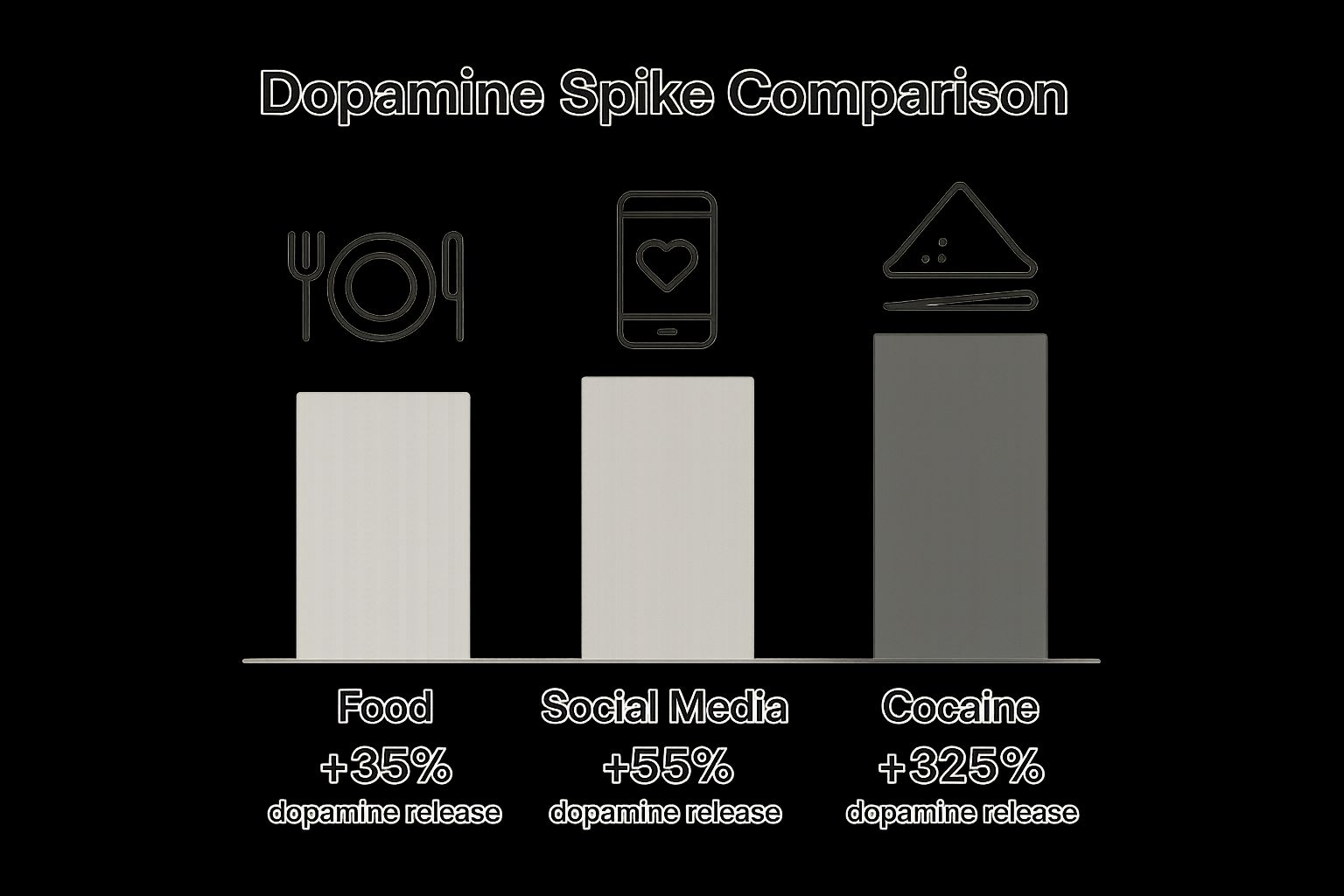
As you can see, some behaviors are far more compelling than others. Things like addictive drugs create a massive, unnatural surge that healthy, everyday activities simply can't compete with.
Healthy Dopamine Function vs The Addictive Cycle
Recognizing the difference between a healthy, balanced dopamine response and a dysregulated, addictive cycle is the first real step toward taking back control. In a healthy state, dopamine motivates you to achieve your goals and enjoy life. In an addictive cycle, it traps you in a loop of compulsive behavior you can't seem to escape.
This table breaks down the key differences.
Healthy Dopamine Function vs The Addictive Cycle
| Aspect | Healthy Dopamine Response | Dopamine Addiction Cycle |
|---|---|---|
| Trigger | Natural rewards like exercise, finishing a task, or connecting with friends. | Hyper-palatable foods, endless social media notifications, or addictive substances. |
| Motivation | A gentle nudge toward beneficial behaviors and long-term fulfillment. | An intense, urgent craving for an immediate but short-lived reward. |
| Outcome | Feelings of satisfaction, accomplishment, and genuine contentment. | A brief high followed by a crash, leaving you feeling empty and wanting more. |
| Control | You are in the driver's seat and can choose to engage or disengage. | The behavior feels compulsive and out of your control, even when it causes problems. |
| Long-Term Effect | Promotes a balanced mood, sustained focus, and overall well-being. | Leads to tolerance, withdrawal, and a dulled ability to enjoy simple pleasures. |
Being honest about where your own habits fall on this spectrum is critical. When the hunt for that next dopamine hit starts getting in the way of your health, your work, or your relationships, it’s a clear sign the cycle has become a problem. The great news is, you're not stuck. With intentional effort and the right strategies, you can absolutely reset this system.
How Your Brain Gets Hooked on a Feeling
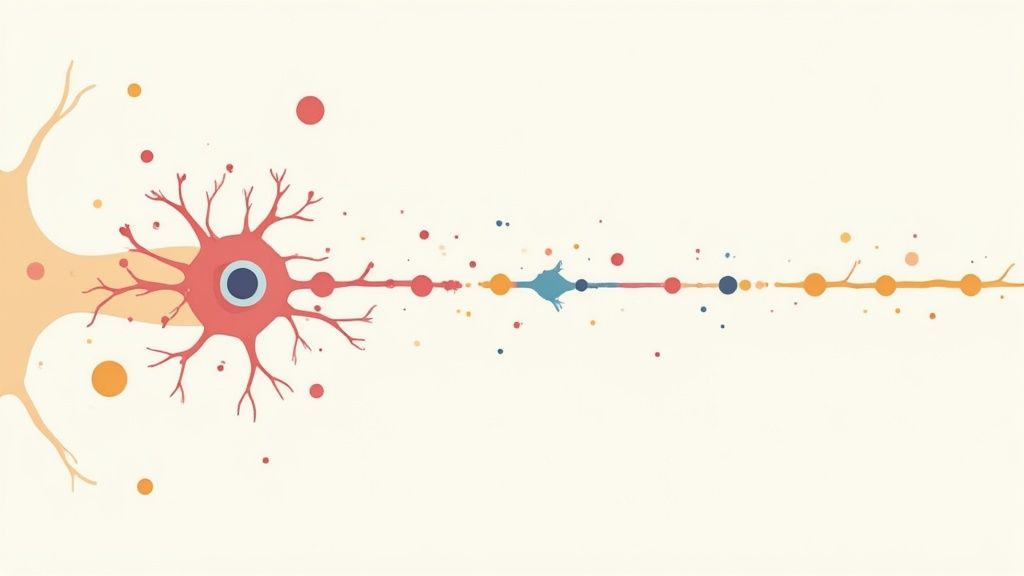
Ever feel like you’re fighting a losing battle against a bad habit? It’s not a lack of willpower—it's your brain's basic wiring. Deep inside your brain is a powerful circuit called the mesolimbic pathway, but you can just think of it as your reward system.
This system is designed to keep you alive. When you do something that feels good, like eating a delicious meal or laughing with a friend, this pathway lights up. The chemical messenger dopamine zips through, sending a simple, powerful message: "Yes! That was good. Let's do that again." It’s the brain’s way of giving you a pat on the back for doing things that help you survive and thrive.
The Dopamine Flood That Hijacks Your Brain
Here's where things get complicated. Our modern world is full of things that don't just create a little trickle of dopamine; they unleash a tidal wave. Think about hyper-palatable processed foods, the endless scroll of a social media feed, or the thrill of a video game. These activities flood the brain with far more dopamine than it ever evolved to handle, creating an intense, memorable high.
Your brain, ever the diligent student, takes detailed notes. It doesn't just remember that the cookie was tasty. It remembers the smell of the bakery, the time of day you usually have a snack, and the feeling of the wrapper in your hand. This is why just seeing a candy jar on a coworker's desk can trigger an intense, out-of-nowhere craving. Your brain is already anticipating the reward it knows so well.
Your brain's reward system is built on a simple feedback loop: do something good, get a dopamine reward, and feel motivated to do it again. When an activity provides an instant, massive dopamine rush, the brain starts to prioritize it above everything else, turning a simple "want" into a desperate "need."
This powerful cycle is the very essence of what is dopamine addiction. The brain starts craving the quick, easy hit over activities that offer more subtle, long-term satisfaction. Over time, this constant chase for a dopamine flood leads to two major changes that lock you into the addictive cycle.
Tolerance and Withdrawal: The Two Pillars of Addiction
First, your brain builds up tolerance. Think of it like listening to your favorite song on repeat. The first few times, it’s amazing. After the 50th time, you barely even notice it. Your brain does the same thing with a dopamine overload. To protect itself from the constant barrage, it starts to shut down some of its dopamine receptors.
The result? You need more and more of the same thing just to feel the original rush. One scoop of ice cream doesn't do it anymore; now you need the whole pint. This is tolerance in action, and it’s why the habit spirals out of control.
Second, you experience withdrawal. When you stop the high-dopamine activity, your brain—now used to a flood—feels starved. Everyday pleasures like a walk outside or a quiet conversation suddenly feel dull and lifeless.
This dopamine deficit creates a whole host of miserable physical and emotional symptoms:
- Anxiety: A constant, nagging sense of unease.
- Irritability: Lashing out for no real reason.
- Restlessness: The feeling of being unable to settle or focus.
- Low Mood: A persistent feeling of sadness or emptiness.
These withdrawal symptoms are your brain’s emergency alarm, screaming for another dopamine hit just to feel normal again. You’re no longer chasing pleasure; you’re just trying to escape the pain. This vicious cycle of tolerance and withdrawal is how a natural survival mechanism gets hijacked, leaving you feeling utterly stuck.
Subtle Signs of a Dysregulated Dopamine System
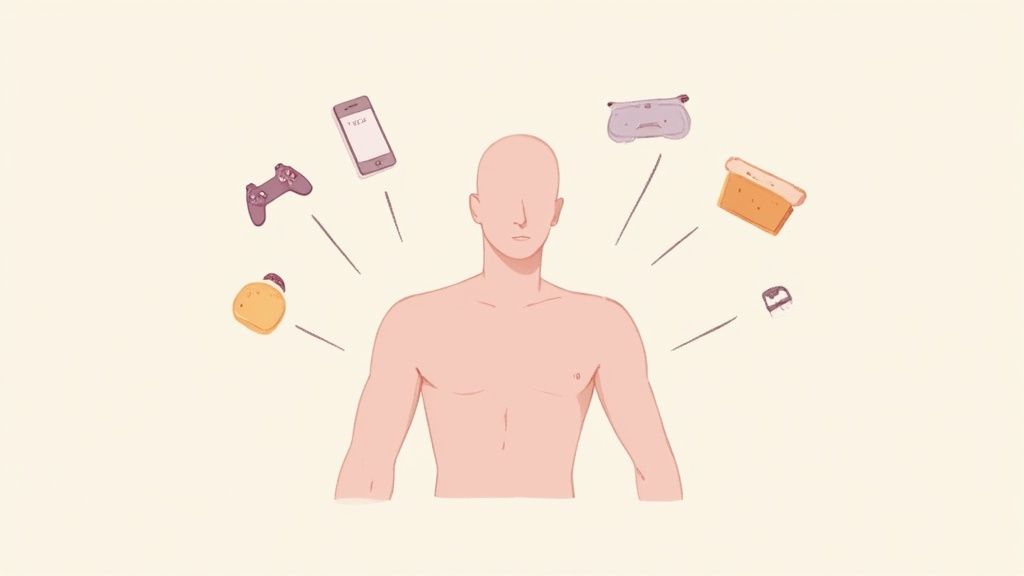
When your dopamine system goes haywire, it doesn't always announce itself with a bang. It's often more of a quiet creep, showing up as small, subtle shifts in your mood and daily habits. You might just brush them off as having "a bad week" or chalk them up to the stress of a busy life, never connecting the dots to a deeper issue.
But these little signs are your brain’s way of sending up a flare, signaling that its internal reward system is seriously out of whack. Learning to spot them is the first, most crucial step toward understanding the grip of dopamine addiction and finally starting to get your energy, focus, and joy back.
The Loss of Simple Pleasures
One of the most telling yet overlooked signs is when the simple things in life start to feel… well, bland. This is a classic symptom called anhedonia, and it’s the reduced ability to feel pleasure from activities you used to love. A beautiful sunset, a quiet walk, or a great chat with a friend might suddenly feel flat or even boring.
What’s happening here? Your brain has gotten so used to the massive, immediate dopamine fireworks from things like sugary treats or endless social media scrolling that it’s become desensitized. The smaller, more natural sources of joy just can't compete. Your baseline for what feels "good" has been artificially jacked up, making everything else feel dull by comparison.
Constant Boredom and Restlessness
Do you find yourself in a constant state of boredom? Feeling restless and unable to just settle into one thing for more than a few minutes? That's another major red flag. Your brain is stuck in a frantic search for its next hit, which makes it nearly impossible to engage with anything that doesn’t offer an instant payoff.
This can look like:
- Endless Scrolling: You pick up your phone to check one quick thing, and suddenly an hour has vanished. You've scrolled through three different apps and can't even remember what you saw.
- Task Switching: You’re bouncing between a work project, a few household chores, and your phone without ever getting traction on any of them.
- Inability to Relax: Even when you’re supposed to be taking a break, there's a nagging feeling that you should be "doing something," which usually leads you right back to your high-dopamine habits.
This relentless hunt for stimulation robs you of your ability to be present and makes deep, focused work feel like climbing a mountain. It's a cycle that's often worsened by external pressures, where issues like burnout and nervous system dysregulation can feed directly into these feelings of unease.
Procrastination and Low Motivation
When your dopamine system is out of balance, your motivation plummets. Big, important tasks that require real effort—like finishing a report or starting that home project—feel completely overwhelming. The delayed gratification they promise just can’t hold a candle to the instant reward of checking your email one more time or grabbing a cookie.
You're not lazy; it's a neurochemical imbalance. You find yourself putting off crucial responsibilities for low-effort, high-reward distractions. Your brain is simply prioritizing the quick fix over the long-term win, which creates a vicious cycle of procrastination, guilt, and stress. This pattern is incredibly similar to the behaviors seen in other reward-seeking loops, like the specific signs of sugar addiction.
Here is a quick look at how these symptoms can play out in different parts of your life.
Symptoms of a Dysregulated Dopamine System
| Category | Symptom | Real-World Example |
|---|---|---|
| Emotional | Anhedonia | Losing interest in hobbies you once loved, like gardening or reading. |
| Cognitive | Poor Concentration | Finding it impossible to read a book for more than a few minutes without getting distracted. |
| Behavioral | Compulsive Behavior | Mindlessly scrolling through social media for hours, even when you're not enjoying it. |
| Emotional | Mood Swings | Feeling irritable and agitated when you can't get your "fix," like a sugary snack. |
| Cognitive | Procrastination | Putting off an important work deadline to binge-watch a new TV series instead. |
| Behavioral | Restlessness | Feeling unable to sit still and relax without reaching for your phone. |
Recognizing these patterns isn't about placing blame; it's about understanding what's happening in your brain so you can start to address it.
The Sneaky Link Between Sugar and Dopamine
Out of all the things in our modern world that can mess with your brain's reward system, one is hiding in plain sight: sugar. It’s everywhere. We use it to celebrate, to start our mornings, and to find comfort after a long day. This makes the connection between dopamine and sugar one of the most powerful and common ways a simple habit can turn into a difficult cycle of cravings.
When you eat sugar, it doesn't just taste good. It sets off fireworks in your brain’s reward center, much like some addictive drugs do. That intense sweetness causes a huge dopamine release, sending a loud and clear message: "This is amazing! Do it again!" Your brain doesn't just taste "sweet"; it interprets it as a high-value reward that’s crucial for survival, creating a powerful memory that pulls you back for more.
And this is no accident. The food industry has spent decades mastering how to tap directly into this system.
How Food Is Engineered for Addiction
Food scientists actually have a name for the perfect, irresistible combination of sugar, fat, and salt. They call it the "bliss point."
Processed foods are carefully designed to hit this exact point, squeezing the maximum amount of dopamine release out of every bite. This makes the food not just delicious, but almost addictive.
Think of it like a pop song with an unforgettable, catchy chorus. The "bliss point" is the brain's version of that chorus—it gets stuck in your head and makes it nearly impossible to have just one cookie, one chip, or one sip. Your brain is getting a super-sized signal it was never designed to handle.
This is why truly understanding dopamine addiction is so crucial when looking at your diet. The pattern that follows is predictable, powerful, and utterly exhausting.
The Vicious Cycle of Sugar Highs and Crashes
That "sugar rush" you feel is the classic dopamine loop in action. It almost always plays out in three stages, over and over again.
- The High: Right after you eat something sugary, your blood sugar soars and dopamine floods your brain. For a short time, you feel incredible—full of energy, happy, and sharp. Your brain immediately records this feeling as a major win.
- The Crash: To handle all that sugar, your body releases a flood of insulin. But it often overdoes it, causing your blood sugar to plummet. This is the dreaded "sugar crash" that leaves you feeling tired, irritable, and mentally foggy.
- The Craving: Now that you're in this low-energy state, your brain desperately remembers the quick fix that made it feel so good just a little while ago. The dopamine deficit kicks in, triggering a powerful urge for another sugar hit to pull you out of the slump. This is a huge reason why you crave sugar when your energy dips.
This cycle isn't just about willpower; it’s rooted in our brain chemistry. Research has shown that our individual dopamine response can predict who is more likely to develop compulsive habits. Animal studies also show that those with naturally higher dopamine activity tend to be more impulsive and seek out new rewards, putting them at greater risk for addiction. For a deeper dive, you can discover insights into the neurobiology of addiction.
Each time you give in to the craving, you're strengthening a pathway in your brain. You're teaching it that sugar isn't just food—it's the solution to feeling tired, sad, or stressed. Over time, that pathway becomes a well-worn highway, making the habit even harder to break.
This constant rollercoaster of dopamine spikes and crashes does more than just affect your weight. It messes with your mood, drains your energy, and kills your focus. Seeing the sugar-dopamine connection for what it really is—a powerful biological trap—is the first real step toward taking back control and breaking the cycle for good.
Practical Strategies to Reset Your Brain
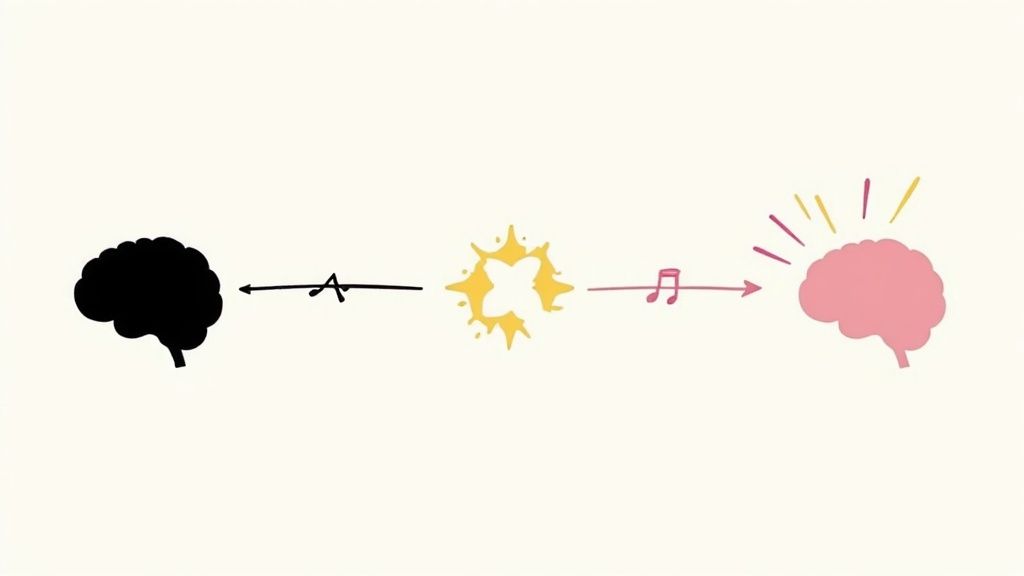
Understanding the science behind your cravings is a great start, but real change only happens when you put that knowledge into action. It's time to move from theory to practice with some solid, science-backed strategies to break the dopamine-seeking cycle and recalibrate your brain.
Let’s be clear: the goal isn’t to get rid of dopamine. That’s impossible, and you wouldn't want to anyway. The real aim is to reset your brain's sensitivity so you can find joy in simpler, more sustainable pleasures again.
This process is often called a "dopamine fast," but I prefer to think of it as a dopamine reset. You're teaching your brain to appreciate a gentle stream of satisfaction rather than constantly chasing a flood. By intentionally stepping back from the things that overstimulate you, you give your dopamine receptors a much-needed break to recover. This helps restore balance, making everyday life feel rewarding again.
Start with a Dopamine Detox
A dopamine detox is about consciously cutting yourself off from your biggest high-dopamine triggers for a set period. It could be a day, a weekend, or even a full week. The idea is to starve that overstimulated reward pathway so it can return to a healthier, more normal baseline.
During this time, you actively avoid things like:
- Mindless scrolling on social media
- Binge-watching TV shows or YouTube
- Eating processed foods and sugary snacks
- Playing video games for hours on end
The first day or two might feel rough. You could be bored, antsy, or irritable—all classic signs of withdrawal. Honestly, that's a good sign. It means the reset is working. Push through it, because the clarity and calm that follow are more than worth the initial discomfort. For a deeper dive into this, some people find the 'Dopanope' approach offers a really useful framework.
Replace High-Dopamine Habits with Sustainable Alternatives
Once you’ve cleared some space by hitting pause on the big triggers, the next step is to fill that time with activities that provide a slower, more stable kind of satisfaction. Unlike the sharp spike and sudden crash you get from a cookie or a social media like, these habits build genuine, lasting fulfillment.
Over time, your brain will actually learn to prefer these steadier rewards.
A sustainable dopamine release comes from effortful, engaging activities that connect you to the real world. Think creation over consumption. This shift is fundamental to rewiring your brain for long-term satisfaction instead of short-term fixes.
Try weaving some of these into your routine:
- Physical Exercise: A brisk walk, a good run, or a yoga session releases dopamine and endorphins, giving you a mood boost without the crash.
- Creative Hobbies: Getting lost in drawing, writing, playing an instrument, or gardening requires focus and leaves you with a real sense of accomplishment.
- Mindful Practices: Meditation and deep breathing help you notice cravings without needing to act on them, which is a superpower for impulse control.
- Real-World Connection: A real conversation with a friend or quality time with family provides a deep sense of belonging that no digital interaction can match.
By consistently choosing these healthier options, you're actively https://stopsugar.app/blog/building-healthy-habits that support a balanced brain. It's a gradual process, but with every good choice, you're reinforcing new and better pathways in your mind.
Practice Mindfulness to Navigate Cravings
Cravings are going to happen. It's an inevitable part of breaking any kind of addictive cycle, and those urges can feel incredibly powerful. The trick isn't to fight them head-on but to observe them with a bit of mindful awareness.
Next time a craving hits, don't immediately give in. Try this instead:
- Acknowledge the Feeling: Just say to yourself, "Ah, this is a craving." Naming it puts a little space between you and the urge.
- Get Curious: Where do you feel it in your body? Is it a knot in your stomach? A jittery feeling in your hands? Just notice.
- Observe Without Judgment: Imagine the feeling is a wave. Watch it build, crest, and then fade. You don't have to do anything about it. Your only job is to watch.
- Breathe: Take a few slow, deep breaths. This calms your nervous system and gives the logical part of your brain a chance to get back online.
This simple practice teaches you a profound lesson: cravings are temporary. They always pass, whether you give in to them or not. Every single time you ride out a craving without acting on it, you weaken its power and strengthen your own self-control. It’s how you win the long game.
Your Questions About Dopamine, Answered
It's natural to have questions when you start digging into the science of cravings and addiction. Let's tackle some of the most common ones to clear things up and give you the confidence you need to take back control.
Is Dopamine Addiction a Real Medical Diagnosis?
That’s a great question, and the answer is a bit nuanced. Right now, you won't find "dopamine addiction" listed as a formal clinical diagnosis in medical books like the DSM-5. Think of it more as a powerful way to describe what's happening in your brain.
The term perfectly captures the compulsive, reward-chasing behavior that fuels so many addictions, from sugar to social media. It explains how our brain's reward system can get hijacked, leading to that frustrating cycle of cravings, tolerance, and withdrawal.
So, while a doctor won't officially diagnose you with "dopamine addiction," they will absolutely recognize the patterns of a behavioral addiction or substance use disorder. Those official diagnoses are driven by the very dopamine loops we've been talking about.
"Dopamine addiction" is the 'why' behind the official label. It's the neurochemical story that explains why you feel trapped, even if the diagnosis is something like "Internet Gaming Disorder" or relates to compulsive eating.
Can You Be Addicted to Something Healthy?
Absolutely. It’s less common, but even good habits can twist into an unhealthy dopamine-seeking loop. The real difference comes down to control and consequences.
Take exercise, for example. It’s one of the best natural dopamine boosters out there. But for some people, it can become compulsive. They might start exercising through injuries, skipping important family or work commitments, or feeling crippling anxiety if they miss a single session.
The line gets crossed when the activity is no longer a choice that enhances your life. It becomes a compulsion you feel you cannot control. When chasing that dopamine hit starts causing negative effects in your health, work, or relationships, it’s moved into unhealthy territory.
How Long Does a Dopamine Detox Take to Work?
There’s no magic number here—the timeline for a "dopamine detox" is different for everyone. It really depends on the intensity of the habit and how long you've been in that cycle.
But here’s a general idea of what you might expect:
- Initial Hurdle (Days 2-3): The first few days are almost always the hardest. Expect to feel bored, a bit irritable, and restless. Your brain is essentially protesting the lack of its usual easy dopamine hits.
- Seeing Daylight (Weeks 1-2): After about a week, most people start to feel a real shift. The intensity of your cravings might start to fade, and you’ll notice that simpler pleasures feel more rewarding again.
- Building New Roads (1 month+): True, lasting change happens with consistency. After about a month of sticking with it, you’re not just resisting old habits—you’re building new, healthier neural pathways. You'll likely feel a much stronger sense of balance and control.
Remember, this isn’t about a quick fix. It's about patiently and compassionately recalibrating your brain's reward system for the long haul.
Is Willpower Enough to Overcome This Cycle?
Willpower is part of the equation, but it’s almost never enough on its own. If you frame this as a simple battle of wills, you're setting yourself up for frustration and a lot of unnecessary self-blame. This isn't a moral failure; it's a biological reality.
Your brain has been physically rewired to chase a specific reward with an incredible sense of urgency. Trying to fight that with willpower alone is like trying to stop a river with a flimsy fence—it's exhausting, and eventually, the river will win.
A much smarter approach is to combine your willpower with practical strategies:
- Change Your Environment: Make your triggers difficult to get to. If sugar is your weakness, get the cookies and candy out of your house. Simple, but effective.
- Build a Replacement: Actively swap the old high-dopamine habit with a new, healthier one. Instead of scrolling on your phone, go for a walk.
- Get to Know Your Cravings: Use mindfulness to just notice your urges without immediately acting on them. This simple act of observation slowly robs them of their power.
When you pair your intention with these kinds of strategies, you start working with your brain to rewire it, instead of just fighting against its most powerful impulses.